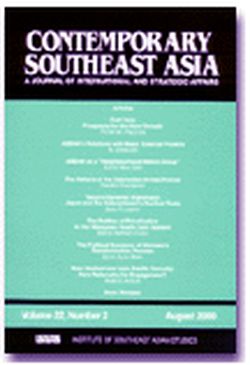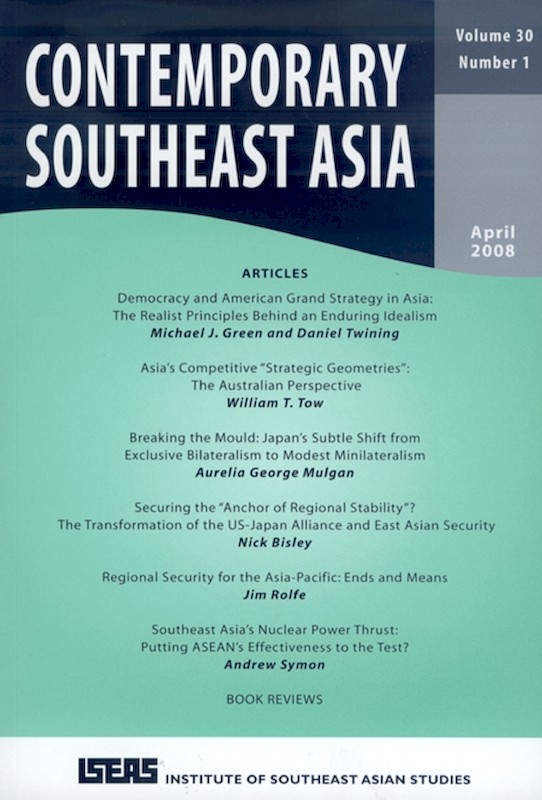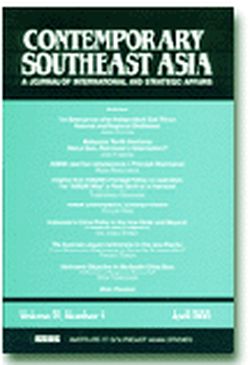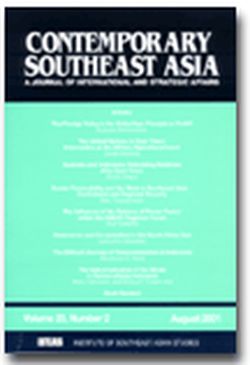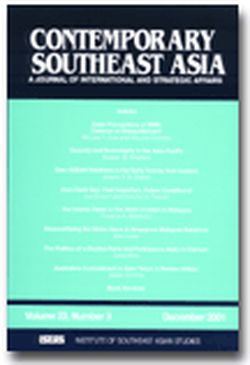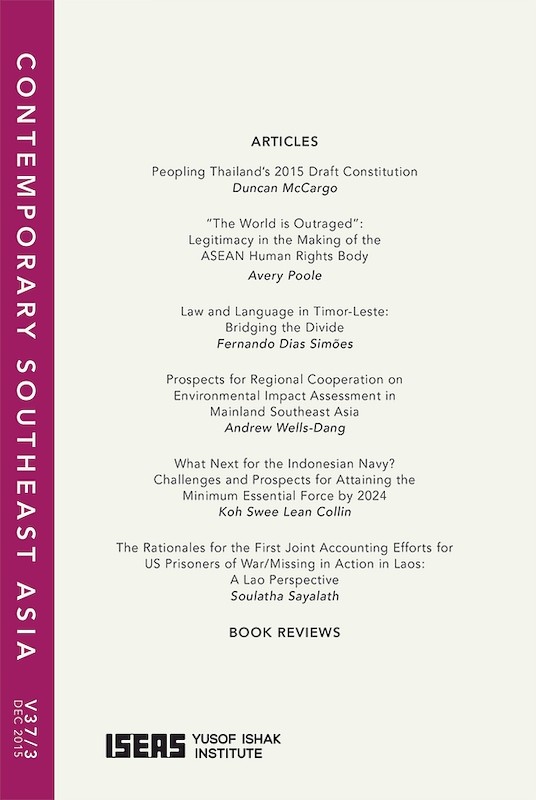Contemporary Southeast Asia: A Journal of International and Strategic Affairs Vol. 27/2 (Aug 2005)
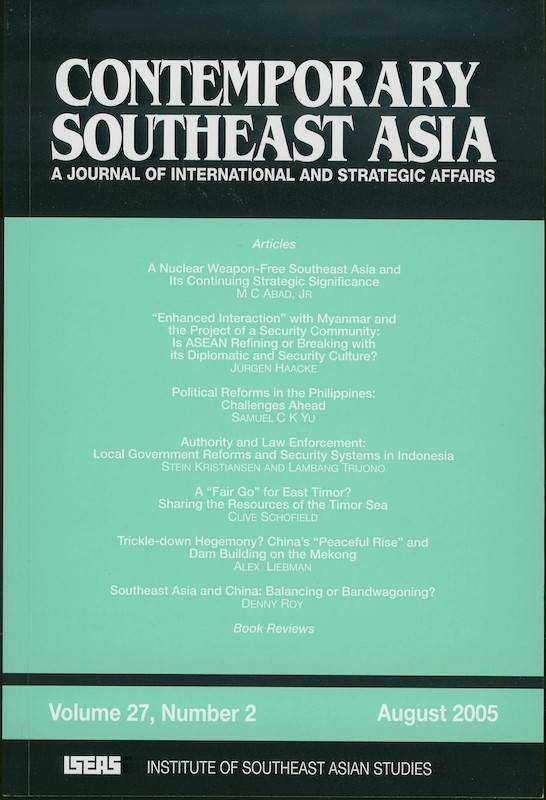
Date of publication:
August 2005
Number of pages:
178
Code:
CS27/2
Contents
-
Contemporary Southeast Asia: A Journal of International and Strategic Affairs Vol. 27/2 (Aug 2005)
-
Preliminary pages
- ARTICLES
-
A Nuclear Weapons-Free Southeast Asia and Its Continuing Strategic Significance, by M C Abad, Jr, author see abstract2005 marks the tenth year since the ten countries of Southeast Asia declared the region a nuclear weapon-free zone. Under the new and fast evolving strategic environment, is the original purpose of establishing the zone still valid? This article will suggest that SEANWFZ remains strategically relevant because it conveys a message of peace, contributes to the global campaign against the proliferation of nuclear weapons, adds pressure to the Nuclear Weapon States to pursue nuclear disarmament and contributes to building the confidence of Southeast Asian countries in managing their common security and exercising a good measure of control over their destiny. It is also relevant to today's counter-terrorism efforts by ensuring that WMD materials, and technology from which nuclear weapons could be developed, do not fall into the hands of terrorists or be transmitted through the Zone.
-
"Enhanced Interaction" with Myanmar and the Project of a Security Community: Is ASEAN Refining or Breaking with its Diplomatic and Security Culture?, by Jürgen Haacke, author see abstractThis article explores whether ASEAN's approach toward Myanmar since May 2003 and the agreed ASEAN Security Community (ASC) concept can be seen to represent major developments in ASEAN's diplomatic and security culture. The article explains that ASEAN's recent diplomatic practice vis-Ã-vis Yangon qualifies as enhanced interaction. It also shows that the Declaration of ASEAN Concord II and related documents underscore the collective commitment among ASEAN states to pursue a limited refinement of ASEAN's normative terrain. However, in view of the limits of enhanced interaction as well as the opposition to the original Indonesian proposal to develop an ASC the paper concludes that it is best to view both ASEAN's recent diplomatic practice and efforts to stake out a larger role for ASEAN in preventing, managing and resolving intra-state conflicts and inter-state disputes as not only being in line with, but also as reaffirming the norms and practices of ASEAN's diplomatic and security culture.
-
Political Reforms in The Philippines: Challenges Ahead, by Samuel C K Yu, author see abstractWhile Filipinos reclaimed their liberties after the downfall of Mr. Marcos in February 1986, scholars began wondering about the eventual success of political reforms in the archipelago, particularly because of sustained conflicts in the rebellion on Mindanao Island and potential military threats to the ruling government such as the one-day abortive coup on 27 July 2003. This article argues that the Philippines has changed the nature of its regime from an authoritarian one to an electoral democracy, but a liberal democracy has not yet matured in the archipelago. The key reason is that there are challenges ahead in the ongoing process of political transition in the archipelago, including the threat of military coup and secessionist movements, slow economic growth, and the need to evolve a time-tested democratic culture.
-
Authority and Law Enforcement: Local Government Reforms and Security Systems in Indonesia, by Stein Kristiansen, Lambang Trijono, authors see abstractThis article aims to assess the impact of decentralization and deregulation reforms in Indonesia on security and law enforcement. The research draws on qualitative and quantitative data from interviews, focus group discussions and household surveys in four selected districts. The main conclusions are that local security guards are developed without control by the central government or democratic bodies at the local level. There is a total lack of transparency and accountability in security affairs and much power is concentrated in the hands of the district heads, the bupati. Policy recommendations include increased central government control over policing, security organizations and law enforcement.
-
A "Fair Go" for East Timor?: Sharing the Resources of the Timor Sea, by Clive Schofield, author see abstractA steady reduction in the United Nations presence in East Timor coupled with failure to reach an agreement with Australia concerning control over vast offshore oil and gas deposits in the Timor Sea raised fears of East Timor (Timor Leste) sliding towards becoming a failed state only three years after finally achieving independence from Indonesia after a quarter of a century of violent struggle. The draft agreement between Australia and East Timor on sharing the contested seabed resources lying between them, finalized in May 2005, has the potential to transform this scenario. This article explores the key economic and security challenges facing East Timor as a prelude to an evaluation of the question of maritime boundary delimitation in the Timor Sea, including analysis of the positions of the contending parties and assessment as to whether the new agreement represents a just and equitable resolution of the dispute (in Australian parlance, a fair go) for East Timor.
-
Trickle-down Hegemony? China's "Peaceful Rise" and Dam-building on the Mekong, by Alex Liebman, author see abstractThis article focuses on Chinese actions on the Mekong (Lancang) river. Ultimately, it concludes that Chinese behaviour on the Lancang does not conform to that predicted by the theory of the peaceful rise China has by and large pursued its own interests without regard for how these actions will affect its downstream neighbours.
-
Southeast Asia and China: Balancing or Bandwagoning?, by Denny C Roy, author see abstractSoutheast Asian states as a group employ two general strategies to protect themselves against domination by a strong China: engagement and hedging. The hedging includes maintaining a modest level of defense cooperation with the United States, which may be called low-intensity balancing against China. This is most clear in the cases of the Philippines and Singapore, and more subtle in the cases of Vietnam, Malaysia and Indonesia. Thailand appears to practice simple hedging, while Burma has no alternative to cooperation with China. The region bandwagons with China only to the extent that it desires trade with China and seeks to avoid the costs of alienating the regions rising great power. These findings suggest the region is far from passive, the United States is still a relevant player, and acceptance of China is premised on Beijing's adherence to the promises made in its recent diplomatic campaign.
- BOOK REVIEWS
-
BOOK REVIEW: Contesting Malayness: Malay Identity Across Boundaries. Edited by Timothy P. Barnard, by Diane K. Mauzy, author
-
BOOK REVIEW: The Thaksinization of Thailand. By Duncan McCargo and Ukrist Pathmanand, by Thitinan Pongsudhirak, author
-
BOOK REVIEW: Regionalism and Multilateralism: Essays on Cooperative Security in the Asia-Pacific. By Amitav Acharya, by Renato Cruz De Castro, author
-
BOOK REVIEW: Japan's Role in Asia: Mutual Development or Ruthless Competition. By Lim Hua Sing, by William Tow, author
-
BOOK REVIEW: Asian Discourses of Rule of Law: Theories and Implementation of Rule of Law in Twelve Asian Countries, France and the U.S. Edited by Randall Peerenboom, by Rajenthran Arumugam, author

